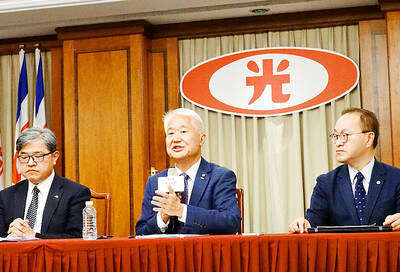The just-introduced (and just-canceled) Pontiac Solstice coupe is already assured a place in automotive history, and not only because its fleeting production run lasted mere months.
This new targa-top Solstice is the last of the Pontiacs, the final breath of a brand that failed to adapt to a changing world. Once-proud Pontiac is being phased out by General Motors, its parent, and will be gone next year. The Solstice coupe, a fixed-roof variation of the four-year-old roadster, is Pontiac’s last new model.
It could become something of a collector’s item.

PHOTO: NY TIMES NEWS SERVICE
“We expect that total production will be in the neighborhood of 1,100 units when we cease operations at the Wilmington plant by the end of July,” Jim Hopson, a Pontiac spokesman, wrote in an e-mail message.
All Solstice coupes will have sequential ID numbers, so owners will know exactly which car of the 1,100 they have.
The coupe I tested was the hot GXP version, which comes with a 260-horsepower 4-cylinder engine. Its window sticker of US$31,045 created an expectation of polish and comfort that I felt, considering the price, it failed to deliver.
Here is a car that essentially matches my definition of a doomed romance. Its drop-dead gorgeous exterior made me yearn for a fling that would turn meaningful, but a week of companionship revealed a list of quirks that included nearly every imaginable character flaw. A love-hate relationship, I suppose, was inevitable.
The spartan cabin, finished in unrelenting black on my test car, was especially noteworthy: I believe it could be the first automotive interior styled entirely by an accounting department. The only minimum-security prison I have ever visited (honest, it was only to interview an inmate) had more luxurious appointments.
The seats are tolerable, but neither supportive nor particularly adjustable — there is no place else for them to go in the cramped cockpit. Plus-size drivers should shop elsewhere.
There is virtually no convenient storage — no handy place for a cell phone, no bin to hold coins, no storage in the enormous console, no cubbies or map pockets in the doors. But there is a slit along the door sill, long enough and wide enough for a package of Slim Jim jerky.
A package shelf under the hatchback rear window is only large enough to hold the bare essentials for a weekend getaway. But if you pop for the temporary fabric top to use when the removable panel has been left home (there’s no place onboard to stash the targa panel), the package area is commandeered to store that. So plan your trips carefully, paying close attention to the weather forecast.
The power window controls are perfectly placed for someone with 15cm-long forearms; otherwise, use your elbows. The dashboard instruments are partly eclipsed by the adjustable steering wheel, regardless of its position. The gauge faces and the radio’s digital display panel can be difficult to read, but, hey, it’s only a problem during most daylight hours.
The shifter for the five-speed manual transmission clanks like a tenement radiator in February. Wind and road noise with the top shut is intrusive enough to warrant constant checks that the windows are all the way up and doors aren’t flapping open.
Despite its many faults, the shapely little coupe is a sexy attention-getter, another beauty designed by Franz von Holzhausen when he was a rising star at General Motors. (Von Holzhausen subsequently left for Mazda and is now at Tesla.) Outward visibility is atrocious, but that’s the price of being so stylish. If you can’t live with that, buy an old Volvo wagon.
Creature discomforts aside, friends and family all wanted to ride in the coupe, the longer the trip the better. Beware of straying too far from home, though: Consumer Reports found the reliability record of the Solstice convertible and the similar Saturn Sky to be dismal.
So what sort of epitaph, if any, does the Solstice GXP coupe suggest for the once-mighty Pontiac nameplate? In many ways it is a rolling testament of GM’s shortsightedness: a pinch of pizazz, a dash of panache, all mixed into a package of unmet promise.

People can preregister to receive their NT$10,000 (US$325) cash distributed from the central government on Nov. 5 after President William Lai (賴清德) yesterday signed the Special Budget for Strengthening Economic, Social and National Security Resilience, the Executive Yuan told a news conference last night. The special budget, passed by the Legislative Yuan on Friday last week with a cash handout budget of NT$236 billion, was officially submitted to the Executive Yuan and the Presidential Office yesterday afternoon. People can register through the official Web site at https://10000.gov.tw to have the funds deposited into their bank accounts, withdraw the funds at automated teller

PEACE AND STABILITY: Maintaining the cross-strait ‘status quo’ has long been the government’s position, the Ministry of Foreign Affairs said Taiwan is committed to maintaining the cross-strait “status quo” and seeks no escalation of tensions, the Ministry of Foreign Affairs (MOFA) said yesterday, rebutting a Time magazine opinion piece that described President William Lai (賴清德) as a “reckless leader.” The article, titled “The US Must Beware of Taiwan’s Reckless Leader,” was written by Lyle Goldstein, director of the Asia Program at the Washington-based Defense Priorities think tank. Goldstein wrote that Taiwan is “the world’s most dangerous flashpoint” amid ongoing conflicts in the Middle East and Russia’s invasion of Ukraine. He said that the situation in the Taiwan Strait has become less stable

CONCESSION: A Shin Kong official said that the firm was ‘willing to contribute’ to the nation, as the move would enable Nvidia Crop to build its headquarters in Taiwan Shin Kong Life Insurance Co (新光人壽) yesterday said it would relinquish land-use rights, or known as surface rights, for two plots in Taipei’s Beitou District (北投), paving the way for Nvidia Corp to expand its office footprint in Taiwan. The insurer said it made the decision “in the interest of the nation’s greater good” and would not seek compensation from taxpayers for potential future losses, calling the move a gesture to resolve a months-long impasse among the insurer, the Taipei City Government and the US chip giant. “The decision was made on the condition that the Taipei City Government reimburses the related

FRESH LOOK: A committee would gather expert and public input on the themes and visual motifs that would appear on the notes, the central bank governor said The central bank has launched a comprehensive redesign of New Taiwan dollar banknotes to enhance anti-counterfeiting measures, improve accessibility and align the bills with global sustainability standards, Governor Yang Chin-long (楊金龍) told a meeting of the legislature’s Finance Committee yesterday. The overhaul would affect all five denominations — NT$100, NT$200, NT$500, NT$1,000 and NT$2,000 notes — but not coins, Yang said. It would be the first major update to the banknotes in 24 years, as the current series, introduced in 2001, has remained in circulation amid rapid advances in printing technology and security standards. “Updating the notes is essential to safeguard the integrity